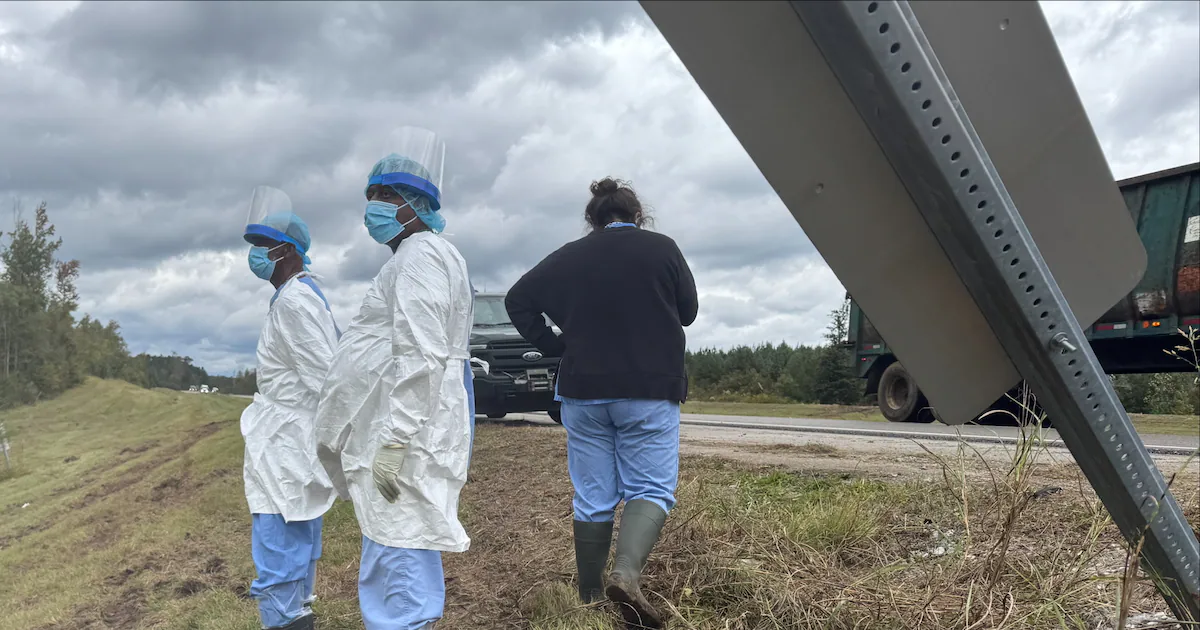Copyright Salt Lake City Deseret News

The Jasper County Sheriff’s Department in Mississippi destroyed all but three monkeys that at last report were still on the loose after escaping from an overturned truck that was transporting them. The animals were disease-free and posed no risk of infecting people, according to Tulane National Biomedical Research Center, which regularly provides rhesus monkeys to other research facilities. “Nonhuman primates at the Tulane National Biomedical Research Center are provided to other research organizations to advance scientific discovery. The primates in question belong to another entity, and they have not been exposed to any infectious agent. The nonhuman primates were NOT being transported by Tulane, but we are actively collaborating with local authorities and sending a team of animal care experts to assist as needed,” Tulane University said in a statement. The sheriff’s department posted on Facebook that the driver of the truck said the animals posed a threat and were so infectious that personal protective equipment was required to handle them safely. According to CBS News, after the crash Tuesday, “Video showed monkeys crawling through the tall grass on the side of Interstate 59 just north of Heidelberg, Mississippi, with wooden crates labeled ‘live animals’ crumpled and strewn about.” In an updated post on Facebook, the sheriff’s department wrote that based on what it was initially told, law enforcement had warned the public that the “aggressive-to-humans” rhesus monkeys weighed about 40 pounds each and “carry hepatitis C, herpes and COVID.” News was later updated to indicate the monkeys weigh less than 20 pounds and had no illnesses or possibility of infecting humans. Fear of catching an illness from animals is nothing new — and it does, in fact, sometimes happen. And it’s not just animals in the wild that can carry disease or pose risk of infection. But animal-loving humans are often willing to take the risk. What cats can spread Feline owners — and there are an estimated 49 million U.S. households that fit the description, according to the American Veterinary Medical Association’s 2024 report — sometimes have to take simple precautions. Pregnant women, for instance, are told not to change kitty litter because of the risk of toxoplasmosis, which is caused by a parasitic protozoan. Most will never have a symptom, but it can be harmful to the infant whose mother is infected in pregnancy. The Cornell Feline Health Center says the average risk of catching a zoonotic disease (one that can transmit from animal to human) is low, but people with weakened immune systems can be at risk. Both very young and very old can fall into that category. Cats are susceptible to rabies and an infected cat that bites a human can transmit the disease. But the most common zoonotic infection from cats is cat scratch disease, caused by a bacterium that can be carried by fleas and then transmitted to humans through scratches, bites or licking an open wound. Most infections come from contact with kittens younger than a year old. Cat mouths can be a source of infection, so bites pose some risk. And salmonella, parasitic infections and fungal infections can all be transmitted to humans. Washing hands after petting or playing with cats, not playing rough and getting a scratch — even a playful one — being careful not to actually touch used cat litter and keeping cats indoors all reduce risk of zoonotic infection. What dogs can do Dogs are the most popular household pets, per the veterinary association. More than 45% of households have at least one and there are about 60 million dog pets in the U.S. The ills carried by dogs sometimes overlap those of cats. Among zoonotic diseases dogs can carry are rabies, leptospirosis with its flulike symptoms from contact with dog urine, Lyme disease, antibiotic-resistant staph infection, salmonella, ringworm and roundworm, according to the Oregon Veterinary Medical Association. The group emphasizes the need to wash hands after contact with pets, pet food and pet bowls, routine cleaning of feeding areas and places where animals go to the bathroom, etc. “Clean pets’ food and water dishes in a separate sink or tub,” per the association, “not in the kitchen or bathtub.” It also says not to bathe an infant in the kitchen sink. Risk from other critters It’s impossible to list all the risks that other animals can pose to humans in certain circumstances. Public health officials have documented cases of the spread of bird flu from cows and chickens to humans in recent years, though not in a high volume. People have always been told not to handle bats, which can carry rabies. And there’s a lot of advice about not handling other sick or dead animals without gloves and other precautions. People can get skin infections, bacteria and parasites from aquarium fish and water if they don’t use proper hygiene, especially if that person has an open cut or wound that gets in the water, per Oregon State University. Don’t clean aquariums in the sink. You should wear gloves when cleaning the fish tank. Fish can also pose a sometimes-serious risk if someone eats undercooked or raw fish. The Cleveland Clinic has a long list of creatures that can pass diseases to people. Rodents can spread hantavirus, plague and salmonella. Sheep and goats can spread Q fever, while reptiles and birds may carry salmonella. Wild birds may spread bird flu or West Nile virus, while monkeys and other primates can spread yellow fever, COVID-19 and rabies — which you could also get from raccoons, skunks and foxes, among others. And deer can be part of the tick-to-humans spread of Lyme disease. Often, animals are infected by the bite of mosquitoes, ticks or fleas that may carry a variety of diseases, including malaria, dengue fever, Lyme disease and West Nile virus, per Cleveland Clinic. No one can avoid all risks. But simple precautions, good hygiene and common sense can keep the risk pretty low.



